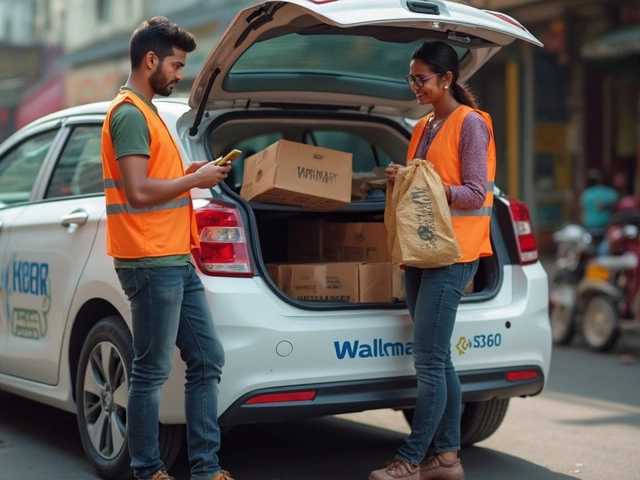Nine times out of ten, the topic of “rate per mile” gets people in the delivery game to perk right up. Why does one company charge more per mile than another? What’s been shaking up the rates in 2025 compared to just a couple of years ago? Turns out, price per mile isn’t just a number thrown at you by a faceless courier company. It’s a living, breathing figure shaped by a crazy mix of fuel costs, demand, the vehicle used, and—yep—even weather patterns. Most folks don’t realize that delivery rates are one of those things everyone kind of complains about but hardly anyone truly understands.
The Real Numbers: Breaking Down the 2025 Rate Per Mile
Let’s get real with some numbers. As of mid-2025, the average rate per mile for standard courier services across the UK is hovering between £1.20 and £2.00. That’s for a regular transit van hauling packages up to a few pallets. But if you zoom in, London? You’re more often staring at the higher end due to congestion and ultra-low emission zones. Up north or in the countryside, you might luck out and snag a deal closer to £1.20 per mile. Why the jump compared to 2023? Blame inflation, higher insurance premiums, plus the ongoing spike in diesel and petrol since early 2024. Don’t be shocked if you see specialist or dedicated express runs with rates pushing £2.50 or even £3 per mile—especially if live tracking or same-day delivery is non-negotiable.
But here’s a wildcard: electric vehicles. Ever since most big fleets started switching to electric vans, some have offered cheaper per mile rates for local city deliveries, with prices a notch below the diesel average. However, for long hauls, you might still get stiffed due to electric vans' range and recharging downtime. Plus, electric charging station fees can make things as expensive as petrol in high-traffic zones or during peak hours.
Pricing isn’t a one-size-fits-all deal. Fragile, oversized, or high-value loads tack on their own surcharges. Companies factor in the actual road distance (not as the crow flies), tolls, parking fees, and—yes—even the likelihood of having to sit in traffic. Some courier firms include their admin costs or a minimum charge that covers short hops, meaning you’ll pay a base rate—often from £20 upwards—even if it’s just a quick two-mile dash.
On top of that, keep your eyes peeled for seasonal surges. Christmas madness or Amazon Prime Day? Rates spike up to 40% higher than average. It’s not uncommon for the same pickup and drop-off combo to swing in price by £100 or more between low and high-demand periods. And, if you’re a regular business shipper, you’ll usually get to haggle down an inch or two on standard rates—especially if you can guarantee a daily or weekly job.
So, how do you really know if you’re getting a fair deal? Don’t just compare rates per mile. Get the courier company to break down what’s included: tracking, insurance, handling charges, or time windows. Most of the time, a slightly higher mileage rate with more included can beat a bargain-basement price that tacks on extras. In short, context always matters more than just the raw price per mile.

What Shapes the Rate Per Mile? Unpacking the Unexpected Variables
Think rates are only about fuel and distance? There’s a whole mess of variables that quietly load up the price. Let’s start with fuel. At its core, fuel is usually the biggest cost, making up at least 35–45% of each mile charged. Since the UK’s fuel excise duty was hiked again in early 2025, that alone pushed most mileage rates up by 10p–12p per mile, overnight. But couriers can’t just eat those costs—they pass them on.
Next, driver pay is eating an ever-bigger slice of the pie. Since the government bumped up the National Living Wage in April 2025, and with a massive driver shortage after Brexit, skilled drivers are in the negotiating seat. That means mileage rates are reflecting higher pay packets, bonuses for drivers who take gnarly shifts, and retention perks.
Then there’s the van itself. Insurance, which shot up in 2024 (remember all those climate protests in cities leading to more vandalism claims?), adds another 5–10p per mile to the typical van’s running costs. Add in vehicle lease payments—now at their priciest thanks to chip shortages and used van price hikes—and you’re seeing direct ripples in per mile charges.
Let’s not pretend tolls and congestion charges aren’t a big deal. Driving through London can slap a courier with a £15–£25 daily charge, just to enter the ring. Nationally, certain bridges and motorway stretches have sneaky tolls that don’t always show up in a flat “rate per mile,” but raise the total quoted cost anyway.
Then, there’s tech. Companies that offer live GPS tracking, instant proof of delivery, or fancy routing algorithms often invest in pricey software subscriptions and hardware. They make up for it by folding those tech costs into their per mile rates—sometimes quietly, sometimes not. You want tracking peace of mind? You’re paying for it in the mileage rate, even if the line item doesn’t spell it out.
And last but definitely not last: demand swings. The rise of home delivery since 2020 flipped the market upside down. With more folks used to next-day or even two-hour delivery, businesses are forced to keep extra vans and drivers on the clock, ready to roll at a second’s notice. During quiet months, couriers drop rates just to keep wheels turning. Come boom periods, prices bounce up in line with crazy demand, and regulars get gobbled up first at the best rates.
It all stacks up to show that a mileage rate is more than what meets the eye. If you’re scouting for couriers, don’t just chase the lowest headline number. Ask about add-on fees, and don’t forget to factor in pick-up and drop-off locations—remote or tricky addresses bump the price up instantly, sometimes by 25% or more.

Smart Ways to Trim Your Delivery Mileage Costs
Feeling like you’re paying through the nose for courier runs? There’s actually a handful of pretty straightforward ways to rein in what you spend per mile for deliveries—if you know where to focus.
First off, timing is everything. Schedule collections and drop-offs to fall outside peak hours (think: before 7 a.m. or after the big city lunch rush). Some vans can take twice as long during traffic slogs, meaning you get stuck with not only a higher bill but sometimes penal “waiting time” fees. Early mornings, evenings, or even overnights often come with a friendly rate or a lower surcharge—so ask if the timing is flexible on your end.
If you run a business and send stuff regularly, pool your loads together. Sending five small shipments over three days each at £1.60 per mile can cost way more than stacking them on a single van run at a sliding-bulk discount rate. Most couriers are happy to chat about bulk rates or contract terms, especially if you dangle reliable, repeat work in front of them. Sometimes, this means negotiating a “milk round” service—one driver, multiple drops, single route, lower overall price. Everyone wins.
Location, location, location. Sometimes, tweaking your drop-off or pickup point by just a couple of miles, like choosing a business park right off a major A-road instead of a winding town centre address, can give you a friendlier rate. Remember, tricky urban locations mean more parking dramas, walking distance, or congestion charges—all translating to a heftier per mile figure. If you have the option, keep things simple and accessible.
It’s tempting to skip out on extras like live tracking, but sometimes paying a tad extra for courier tech is worth it. Real-time tracking helps squash disputes, spot delays, and, for busy businesses, makes it way easier to plan for staff or unloaders at the other end. If speed isn’t crucial, negotiate for a slightly slower time window—standard delivery is always cheaper than dedicated or express, sometimes knocking 25% off your per mile rate.
Got a bit of DIY in you? For ultra-local deliveries, look at using bike couriers or electric scooters—their mileage rates have dropped as low as £0.70 per mile in city centres, with zero congestion charge. Great for local restaurants, flower shops, or even pharmacies needing same-hour drop-offs.
If you’re shipping expensive or fragile goods, always clarify the value covered under standard insurance. Sometimes the courier’s “free” coverage only stretches to £50 or £100; upgrading could add pennies per mile, but it dodges a world of pain if something actually goes missing. Shop around, but always ask for a breakdown of what’s actually included in the “rate per mile” line, so you’re not hit with surprise add-ons.
Want an extra tip? Use online rate calculators and comparison tools. Several sites let you pop in your details and immediately get competitive mileage rates from dozens of couriers. If you’ve got the time, send out a few quote requests. You’ll quickly spot who’s overcharging, who’s got great rates for certain zones, and which couriers value long-term relationships. And when you find a provider you click with—lock in those rates as a fixed contract to dodge future price hikes when fuel or demand takes off.
To wrap it all up, understanding the rate per mile today is more than staring at a chart. It takes asking smart questions, comparing the full package, and getting creative about consolidating your loads. That way, whether you’re an e-commerce seller, a gig worker, a florist, or just someone who needs to move a few boxes, you stay ahead of sticker shock and keep your delivery costs in check—all while making sure your package arrives where and when it should.





